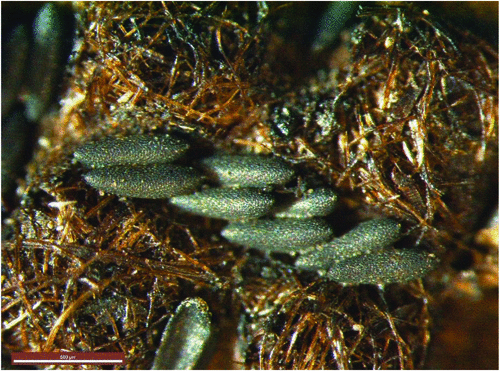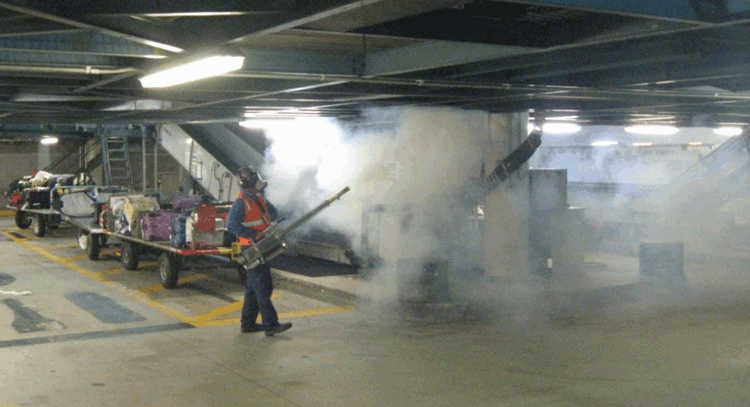Protecting Australia from disease vectors: exotic mosquito management at the border
Angus Sly A and Callum Mack BA Pathway Surveillance and Operational Science, Compliance Division, Department of Agriculture and Water Resources, GPO Box 858, Canberra, ACT 2601, Australia. Email: Angus.Sly@agriculture.gov.au
B Office of Health Protection, Australian Government Department of Health, GPO Box 9848, Canberra, ACT 2601, Australia. Email: Callum.Mack@health.gov.au
Microbiology Australia 39(2) 108-110 https://doi.org/10.1071/MA18032
Published: 13 April 2018
Mosquitoes, through the diseases they transmit, are considered the deadliest animals in the world1. While Australia is relatively free of many of the mosquito species capable of transmitting diseases such as dengue, yellow fever, chikungunya, and Zika virus, Australia is not immune to the risk of these arboviruses becoming endemic through the introduction of exotic mosquito vectors. In 150 separate instances there were 525 individual exotic mosquitoes detected at the Australian border between 2014 and 2017 (Department of Agriculture and Water Resources, unpublished data). Accordingly, there is a strong focus on surveillance and control activities to prevent exotic mosquito incursions and possible local establishment.
Aedes aegypti (Linnaeus) and Aedes albopictus (Skuse) are highly invasive mosquito species responsible for the transmission of diseases significant to public health across many parts of the world. Aedes albopictus is not yet established on mainland Australia and Ae. aegypti is confined to a limited distribution through eastern Queensland2. As a result, diseases such as dengue, chikungunya, Zika virus, and yellow fever are relatively rare or non-existent in Australia. While Queensland continues to experience localised dengue outbreaks stemming from imported cases, the rest of Australia remains free from disease transmission.
The lack of a competent vector dramatically reduces the public health risk posed by arboviral diseases. For example, there were 1740 cases of dengue reported in Western Australia between 2014 and 20173, predominantly associated with overseas travel. This is the highest recorded of any state or territory during this period, but in the absence of a competent vector no dengue outbreaks have occurred. The establishment of either Ae. aegypti or Ae. albopictus in this region of Australia would have significant public health consequences.
Australia’s island geography aids in preventing the introduction of mosquito vectors, but a reliance on imports and increasing international passenger movements has provided a pathway for invasive mosquitoes via international conveyances and imported cargo. To prevent the establishment of vectors through import pathways and maintain a risk free environment with respect to the previously mentioned arboviruses, the Australian Government employs specific measures at the border, primarily: disinsection of all aircraft entering Australia, targeted inspections of international vessels and cargo, and vector surveillance at first points of entry (air and sea ports).
Exotic mosquito surveillance is legislated under the Biosecurity Act 2015 and undertaken by the Australian Government Department of Agriculture and Water Resources. In line with the World Health Organization’s International Health Regulations 2005 surveillance is carried out to a minimum distance of 400 metres from facilities that are used for operations involving travellers, conveyances, cargo, and postal articles4.
The Department of Agriculture and Water Resources deploys a range of mosquito surveillance traps at first points of entry as part of its mosquito surveillance program. These traps are targeted at collecting different life stages of mosquitoes including Biogents Sentinel traps and Encephalitis Vector Surveillance CO2 traps for collecting adults, Sentinel tyre traps for collecting larvae, and ovitraps for collecting mosquito eggs (Figure 1). The vast majority of mosquitoes collected through this program are local species with 117 exotic mosquitoes (37 separate instances) identified from more than half a million mosquitoes collected at Australian first points of entry in 2016 (Department of Agriculture and Water Resources, unpublished data). The type and number of traps deployed at a first point of entry varies according to the size, the volume of arriving international conveyances and cargo, and local environmental conditions at the port. The larger the port or the higher the volume of international traffic arriving at a port, a greater number of traps and trap types are used. Surveillance activities are also escalated at times of heightened international traffic. For example, additional surveillance traps are deployed to cover increased international military arrivals during Australian Defence Force exercises.

|
The detection of a single exotic mosquito will trigger a rapid response involving Federal, State and, in some jurisdictions, Local Government. A typical response to an exotic mosquito detection will involve knockdown adulticide treatments (Figure 2), residual insecticide harbourage spraying, and treatments of potential mosquito breeding sites. Enhanced surveillance is undertaken to monitor the effectiveness of the treatments applied and to ensure no exotic mosquitoes remain. Site surveys around the detection point are undertaken to ensure that there is no localised breeding of exotic mosquitoes. To assist this cross government response, the Australian Government Department of Health has developed a set of guidelines to support decision making and describe the roles and responsibilities of the key stakeholders involved in the response activities5.

|
Pathway analysis is another important part of the response process. Determining the origin of an exotic mosquito and how it arrived allows for targeted control measures to be implemented. Genome-wide single nucleotide polymorphism (SNP) analysis is used as a population genetics tool to compare genetic similarities between exotic mosquitoes detected at the border and an established reference database in order to determine their origins6. This, as well as investigations into insecticide resistance profiles of exotic mosquitoes using genetic markers and biological assays, is helping to better understand new and emerging risk pathways.
To date, pathway controls, early detections of exotic mosquitoes at the border, and rapid response activities have helped prevent exotic mosquito vectors from establishing in Australia, however, exotic mosquitoes continue to probe our borders. Through continued efforts at the border, researchers are provided with more time to develop new and innovative ways to prevent and control these mosquito vectors, and the diseases they transmit ahead of their possible introduction to Australia.
References
[1] World Health Organization (2018) Mosquito-borne diseases. http://www.who.int/neglected_diseases/vector_ecology/mosquito-borne-diseases/en/[2] Queensland Health (2015) Queensland Dengue Management Plan 2015–2020. https://www.health.qld.gov.au/publications/clinical-practice/guidelines-procedures/diseases-infection/governance/dengue-mgt-plan.pdf
[3] Australian Government Department of Health (2018) National Notifiable Diseases Surveillance System. http://www9.health.gov.au/cda/source/cda-index.cfm
[4] World Health Organization (2005) International Health Regulations, 3rd edition, World Health Organization, Geneva, 2016.
[5] Australian Government Department of Health (2017) Response guide for exotic mosquito detections at Australian first points of entry. http://www.health.gov.au/internet/main/publishing.nsf/Content/ohp-exotic-mosquitoes
[6] Rašić, G. et al. (2014) Genome-wide SNPs lead to strong signals of geographic structure and relatedness patterns in the major arbovirus vector, Aedes aegypti. BMC Genomics 15, 275.
| Genome-wide SNPs lead to strong signals of geographic structure and relatedness patterns in the major arbovirus vector, Aedes aegypti.Crossref | GoogleScholarGoogle Scholar |
Biographies
Angus Sly completed a BASc at James Cook University. Mr Sly is an Assistant Director in Pathway Surveillance and Operational Science with the Australian Government Department of Agriculture and Water Resources and is responsible for overseeing the coordination of the department’s mosquito surveillance program at Australia’s first points of entry.
Callum Mack completed a BSc (Hons) in molecular genetics at the University of New England. A senior policy officer with the Office of Health Protection, part of the Australian Government Department of Health, Mr Mack is responsible for exotic mosquito management policies at Australia’s first point of entry.


